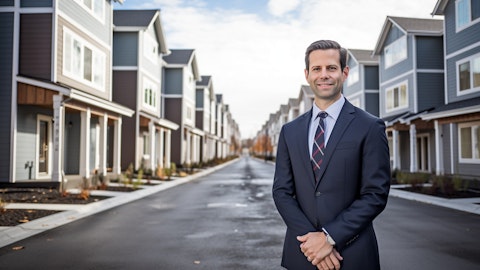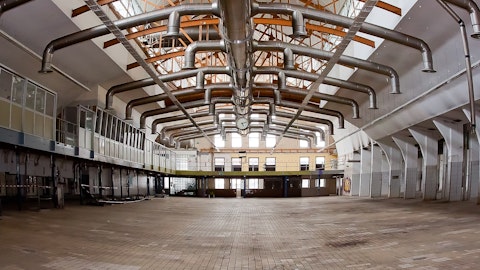Rexford Industrial Realty, Inc. (NYSE:REXR) Q4 2023 Earnings Call Transcript February 7, 2024
Rexford Industrial Realty, Inc. isn’t one of the 30 most popular stocks among hedge funds at the end of the third quarter (see the details here).
Operator: Greetings. Welcome to Rexford Industrial Realty, Inc. Fourth Quarter 2023 Earnings Call. At this time, all participants are in a listen-only mode. A question-and-answer session will follow the formal presentation. [Operator Instructions] I’ll now turn the conference over to your host, David Lanzer, General Counsel. You may begin.
David Lanzer : We thank you for joining Rexford Industrial’s fourth quarter 2023 earnings conference call. In addition to the press release distributed yesterday after market close, we posted a supplemental package and investor presentation in the Investor Relations section on our website at rexfordindustrial.com. On today’s call, management’s remarks and answers to your questions may contain forward-looking statements, as defined by federal securities laws. Forward-looking statements address matters that are subject to risks and uncertainties that may cause actual results to differ. For more information about these risk factors, please review our 10-K and other SEC filings. Rexford Industrial assumes no obligation to update any forward-looking statements in the future.
Additionally, certain financial information presented on this call represents non-GAAP financial measures. Our earnings release and supplemental package present GAAP reconciliations and explanations of why such non-GAAP financial measures are useful to investors. Today’s conference call is hosted by Rexford Industrial’s Co-Chief Executive Officers, Michael Frankel and Howard Schwimmer; together with Chief Financial Officer, Laura Clark. They will make some prepared remarks, and then we will open the call for your questions. Now I turn the call over to Michael.
Michael Frankel : Thank you David, and welcome everyone to Rexford Industrial’s fourth quarter earnings call. I’ll begin with a few remarks followed by Howard, who will provide some additional market and operational detail. Then Laura will provide our financial results and outlook. To begin with, I’d like to thank our Rexford team for your strong results across all of our value creation initiatives. As 2023 marked our 10th year as a public company and our 22nd year as a business focused exclusively on creating value within infill Southern California, it’s a great time to reflect upon our growth and our current position as we look forward to our next decade. Since our public offering 10 years ago, we’ve generated average FFO or earnings per share growth of about 15% per year, which has fueled a total shareholder return of 40% on average per year over the prior 10 years, demonstrating the strength of our team, our highly differentiated business model, and our substantial market opportunity.
2023 was a strong year for the company. We maintained our same property portfolio at essentially full occupancy averaging almost 98%. Our team increased consolidated NOI by over 26%, principally driven by the absorption of 4.3 million square feet of highly accretive new investments, 7.4 million square feet of leasing activity with 78% average net effective rent spreads and embedded rent bumps averaging over 4% and the lease up of half a million square feet of value add reposition projects. Our infill Southern California industrial markets also demonstrated a high degree of resilience over the prior year. We endured prolonged labor contract negotiations at the ports and a post pandemic normalizing of tenant demand exacerbated by increasing interest rates.
Despite last year’s headwinds, rents for quality products similar to our portfolio within infill Southern California demonstrated stability with nominally positive rent growth of about 1.2%. Stability and growth in rents after having increased by well over 80% through the pandemic are a testament to the favorable supply demand fundamentals associated with our infill Southern California industrial markets. As we look forward, although we may see some near-term choppiness in demand for certain size product and select sub-markets, our extended market backdrop looks favorable. Port volumes are trending with accelerated growth driven by a resolution to last year’s port labor negotiations, instability in the Middle East, impacting the Suez Canal, a decline in capacity through the Panama Canal due to a long-term drought and lower cost and shorter timeframes associated with importing from Asia via the ports of LA and Long Beach compared to the East and Gulf Coast ports.
In addition, a more stable interest rate environment may also enable tenants to more proactively commit to their growth and inventory needs. Overall, our team is exceptionally well-positioned to monetize our substantial embedded internal growth, which includes our value add repositioning pipeline comprising over 9 million square feet of space and process or scheduled for repositioning over the next four years and our estimated 51% portfolio-wide net effective mark-to-market for in-place rents providing an opportunity to roll expiring deeply below market leases to substantially higher market rents. Further supporting Rexford’s favorable outlook, we remain focused on maintaining our investment grade, low leverage balance sheet, ending the year at 15% net debt to total enterprise value, which provides the ability to protect the company during uncertain times, while also positioning Rexford to capitalize upon accretive growth opportunities as they may arise.
We are also pleased to announce that we’re increasing our dividend by 10%, bringing our average annual dividend growth to 23% since our public offering about 10 years ago. And with that, I’d like to acknowledge our Rexford team once again for your market leading efforts that continue to drive substantial value creation for our shareholders. And now it’s my great pleasure to hand the call over to Howard.
Howard Schwimmer : Thank you, Michael, and thank you everyone for joining us today. The Rexford team delivered strong fourth quarter and full year results driven by our dynamic team’s performance and our irreplaceable portfolio. Rexford’s fourth quarter and full year operating performance demonstrates our advantageous position within the infill Southern California market. In the fourth quarter, our team executed 1.9 million square feet of lease activity driving 204,000 square feet of positive net absorption, highlighting the sustained demand for our highly functional portfolio. Leasing spreads were 63% and 46% on a net effective and cash basis respectively, and both fourth quarter and full year average embedded rent steps were 4.1%.
We have observed an incremental increase in tenant activity as we ended the year and into the first quarter with activity on over 85% of our vacant space. We have also seen strong renewal activity indicative of the health of our tenants, their ability to pay increased rent in the lack of available functional supply in the market. In the quarter, market rents were flat sequentially for product comparable in quality to the Rexford portfolio. The overall infill market vacancy remains exceptionally low, ending the fourth quarter at 2.75% with nominal positive net absorption according to CBRE. Additionally, port volumes at LA and Long Beach are rebounding with a 22% increase in activity over the prior year quarter, while East and Gulf Coast ports saw a decrease over the same period.

Turning to our investment activity in the fourth quarter, we closed $315 million of investments which are projected to generate an unleveraged stabilized yield of 6.8% on total cost. For the full year, we completed $1.5 billion of investments, which in aggregate are generating an initial yield of 5.4% and are projected to generate a 6.1% unleveraged stabilized yield on total cost. Over 70% of these investments were sourced through off market or lightly marketed transactions. Additionally, we sold two properties for an aggregate sales price of $28 million, which generated a 21% weighted average unlevered IRR. Subsequent to quarter end, we acquired a two building state-of-the-art distribution facility in the San Gabriel Valley submarket for $84 million.
That is generating a 5.4% unlevered initial yield. Looking forward, we currently have an acquisition pipeline of approximately $150 million of investments under contract or accepted offer, which are subject to customary closing conditions. With regard to our repositioning and redevelopment activity in the fourth quarter, we stabilized two projects, what which was released in the quarter, and we also pre-leased our Quay project achieving an aggregate 7.7% unleveraged stabilized yield on the three projects. Notably, the pre-leased activity in the quarter exceeded our most recent rate projections. For the full year, we stabilized six projects, comprising $197 million in total investment and achieved an aggregate 6.9% unleveraged stabilized yield.
In addition, we have 4.7 million square feet of repositioning and redevelopment projects in process or expected to start within the next 18 months. These investments have an aggregate remaining incremental spend of approximately $455 million with a projected stabilized yield of 6.2% on total investment. Finally, I’d like to acknowledge our entrepreneurial Rexford team for their tremendous effort achievements in 2023. And with that, I’m pleased to turn the call over to Laura, discuss our financial results.
Laura Clark : Thank you, Howard. In the fourth quarter, core FFO per share grew 14% over the prior year quarter, driven by same property NOI growth of 9.5% on a cash basis and 8.4% on a net effective basis. Full year core FFO was $2.19 per share ahead of our guidance projections, representing 12% earnings growth. Full year same-property NOI growth came in at the high end of our guidance range at 10% and 8.2% on a cash and net effective basis, respectively. Leasing spreads also topped expectations. With full year cash leasing spreads of 59% and net effective spreads of 78%. As a result of our strong full year performance and Rexford’s continued commitment to delivering superior total shareholder return, our Board declared a first quarter dividend of $0.4175 per share representing a 10% annualized increase over the prior year.
Turning to capital allocation and the balance sheet. We are committed to a disciplined capital allocation strategy focused on driving shareholder value, as demonstrated by our earnings per share growth, which has averaged 16% annually over the past five years, outperforming the peer group by nearly 50%. Our fortress balance sheet positions us to execute on our value creation strategy. At quarter end, net debt-to-EBITDA was 3.6x and net debt to enterprise value was 15%. We maintained substantial liquidity of $1.2 billion, comprised of $138 million of net forward equity currently remaining for settlement. $33 million of cash on hand and full availability on our $1 billion revolver. We have no material debt maturities until 2026, inclusive of extension options.
As we look forward, Rexford’s internal cash flow and earnings growth opportunity is significant. Over just the next three years, we project 42% internal cash NOI growth equal to $240 million of incremental NOI embedded within our in-place portfolio. This is expected to grow total cash NOI to over $800 million over the next three years, assuming today’s rents and no future acquisitions. This includes $95 million of incremental NOI from repositioning and redevelopment stabilizing over the next three years, $95 million Incremental NOI related to the conversion of in-place rents to market rents, $40 million from the average 3.6% annual embedded rent steps in the total portfolio and $10 million from acquisitions completed in the fourth quarter and year-to-date.
This significant internal NOI growth within our existing portfolio is projected to generate average annual core FFO per share growth over the next three years in the 11% to 13% range. In addition, we expect to continue to capitalize upon our substantial external growth opportunity as we expand our current 2.5% market share within the 1.8 billion square foot infill Southern California market. With regard to 2024 guidance, we are projecting core FFO per share in the range of $2.27 to $2.30. As a reminder, our 2024 guidance range does not include acquisitions dispositions or related balance sheet activities that have not yet closed. 2024 cash and net effective same-property NOI growth is projected to be in the range of 7% to 8% and 4% to 5%, respectively, and full year average same-property occupancy is projected to be 96.5% to 97%.
Cash leasing spreads are estimated to be approximately 40% and net effective spreads of approximately 50%. Note that excluding the impact of an assumed fixed rate early renewal from a non-same property tenant in the Inland Empire West. Cash and net effective leasing spread guidance is approximately 50% and 60%, respectively. To provide further detail around the components of our same-property net effective growth, the mark-to-market on the in-place leases within the same property pool at 60% leasing spreads, contributes approximately 750 basis points of growth. This growth is offset by a 200 basis point impact from lower non-cash revenue related to the burn off of straight-line and below-market rents. Last year, we benefited from an outsized amount of early renewals, allowing us to increase rents to higher market rates.
As is our practice, our guidance does not assume the same elevated pace of early renewals in 2024. Our net effective same-property guidance is also impacted by 100 basis points related to lower average occupancy, bad debt as a percentage of revenue that is expected to be in the range of 40 to 50 basis points and higher expenses net of recoveries. In aggregate, these components impact same property net effective NOI growth by approximately 300 basis points, which would have otherwise brought our guide same-property net effective growth to 7.5%. Other components of our FFO per share guidance include 2023 and year-to-date investments are expected to contribute approximately $40 million of incremental NOI and repositioning and redevelopment stabilizations in 2024 are projected to contribute incremental NOI of approximately $13 million, equal to $0.06 per share, offset by a decline of approximately $13 million from NOI coming offline related to projects being placed into repositioning and redevelopment.
Rebooking and a net neutral contribution to 2024 core FFO per share guidance. Before turning the call over for your questions, I want to thank our incredible Rexford team for an outstanding year and your continued commitment to excellence. Rexford’s success is a direct result of your great work. Thank you all for joining us today, and we now welcome your questions. Operator?
See also 20 Best Small Towns in Florida to Retire and Wall Street Analysts See Upside Potential for 10 Stocks with Rising Price Targets.
Q&A Session
Follow Rexford Industrial Realty Inc. (NYSE:REXR)
Follow Rexford Industrial Realty Inc. (NYSE:REXR)
Receive real-time insider trading and news alerts
Operator: [Operator Instructions] Our first question comes from the line of Blaine Heck with Wells Fargo.
Blaine Heck: Michael, you mentioned some choppiness in demand in certain tenant sizes and submarkets. Can you talk a little bit more about that segment of the market? And how long do you think that could be a headwind and then on the flip side, where are you seeing strength or improving demand conditions in your market?
Michael Frankel: Blaine, thanks so much for joining us today. Appreciate it. No, it’s a great question. And as I mentioned, our markets are generally performing well. And where we saw a little bit of excess supply would be in the Inland Empire West, for instance, where during the pandemic, we saw a little bit of exuberant development starts, and that’s really impacting the larger space sizes above 100,000 square feet. And so it’s very much isolated to IE West, where we also see a little bit of softness is in the Central Los Angeles market, really just impacted by the shift utilization of office space and the demand for housing and multifamily in downtown Los Angeles adjusting in the post-pandemic period. The bigger driver really is out IE West and we see that normalizing.
We see absorption even of the larger space occurring over the near to fairly medium term, probably over the next 12 months or so. And the good news for Rexford, frankly, is we only have two spaces in that entire submarket. That even begin to compete in that larger size range. Our average size space is closer to 25,000 square feet. So not really a material threat to Rexford, but it is impacting market dynamics out there for larger space, in particular. And in terms of where we see strength, quite frankly, throughout the rest of the infill markets, meaning Greater LA and Orange County and pockets of Ventura in San Diego, where we own product. We actually saw about 4% market rent growth last year, that’s excluding the IE West. And that’s a pretty favorable growth rate, particularly considering the fact that those markets grew by over 80% during the pandemic.
So we’re seeing great signs in the market that we’re holding these rent levels. And by the way, I’ll just touch back on the IE West. The IE west is a very interesting market also because during the pandemic, we saw rents in the IE West increased by over 160%. So the IE West was an outlier in positive and accelerated rent growth through the pandemic, which may also help explain why we’re seeing normalization in the IE West a little bit different than the rest of the infill markets. But again, we see near-term stabilization in the IE West as well. And with regard to 2024 guidance, I mean, it’s true that we’re seeing strength in the markets. As I mentioned in my remarks, we believe that the markets are favorably positioned. But there are storm clouds out there with regard to geopolitical issues and therefore, continued economic stability, we’re encouraged by a more stable interest rate environment, but we feel it’s prudent at this point in time to be thoughtful and conservative about how we’re setting near-term expectations.
And that having been the case, and I’ll just extend this a little bit, timing has a huge impact on near-term performance. So what I mean by that, I’ll just give you one significant example. Laura mentioned that we have about $0.06 of FFO per share coming in during 2024 as we lease up our value-add reposition projects. And while that’s substantial, but on an annualized basis, on a fully leased up basis, that represents about $0.16 of FFO per share contribution. And although we don’t get the full benefit of that this year, it sets us up to next year and the following year for great growth and actually, we estimate 2025 and ’26 FFO per share growth to be in the 14% to 17% range each for each of those years. So interesting year for Rexford but couldn’t be more excited about how we’re positioned.
Blaine Heck: That is very helpful color there, Michael. And then just switching gears real quick for my second question for Laura thanks for the commentary on GAAP and cash NOI differences. It seems like 1 of the biggest drivers there is just the early renewals that you guys did in 2023 that had free rent that will be burning off this year. I guess, how do you feel about that same thing happening this year? Or what gives you kind of hesitation that that type of activity is going to be maybe more subdued this year?
Laura Clark: Yes, Blaine, great question. In terms of how we forecast, I mean, we certainly take a conservative approach to the timing of renewals. So last year, we did have outsized early renewals, and that contributed, as I mentioned, to the higher straight-line rent revenue. And as we look forward, renewal activity and [indiscernible] mentioned this in his remarks, has been very strong within our portfolio was like that throughout the year. So as we look forward, and we’re in discussions with tenants and more visibility into the timing of renewals, we’ll certainly be updating our guidance accordingly.
Operator: Our next question comes from the line of Camille Bonnel with Bank of America.
Camille Bonnel: I hear a bit of static, so I hope I’m coming through clearly. So it looks like you hit a new record with the 7 million square feet of leasing activity last year. And even on a deal level, you’re up slightly from ’22. So can you talk about how the leasing pipeline is looking for the first few months of the year? And do you expect to continue signing leases at a similar pace?
Howard Schwimmer: It’s Howard. We’re really pleased with the activity we’ve seen building. Looking back in October, November things had slowed down quite a bit. And then towards the end of the year, we saw a significant pickup, and that’s our continued through. So we have a lot of activity — of course, right now, we have to turn that activity into some leases. So Michael mentioned some concerns over the economy and so forth. So sort of a wait and see. And while we are real, real excited. We’ve got some work ahead of us to do in that respect.
Camille Bonnel: Are those concerns around the economy translating into you seeing any changes in the pace of the deals that are being signed? Or has it been more or less consistent with ’23 activity?
Howard Schwimmer: I think I’ll use the word normalization, just thinking back to 2019 pre-COVID levels. Typically, a good example is just talking about some of our repositioned and redevelopment space we were seeing that space lease up in one month, two months. And now we’re seeing that lengthening out, looking more in the four month range, maybe even a little longer. So yes, definitely stretching out, but nothing unusual compared to what you’d see in a typical normalized functioning market. And also the activity we’re seeing really picked up, I think, when you think about the first half of the year and then pushing really into the second in terms of our expirations also even going forward, I think we have a lot more space expiring later than sooner.
Camille Bonnel: Right. So that actually leads me to my just last follow-up on the repositioning program and the guidance you provided around $0.06 contribution. Just given many of these are yet to be leased, how confident are you in reaching this target? And what are you tracking that needs to happen for there to be upside to this.
Michael Frankel: Camille, it’s Michael. Yes. No, I think we’re very confident actually in our — the expectations we’re setting with respect to the repositioning and upside would be in the form of reduced time frame for lease-up and maybe we beat our target rents. And — we’re going to work hard to do both of those. But we’d like to set expectations in a way that we feel is appropriate given the environment and also maybe does leave the opportunity for some pleasant surprises.
Howard Schwimmer: And Camille, I’ll just add that these repositionings, redevelopments, especially even the redevelopments, they’re really all in very tight infill markets and when you start looking at the competing space, there’s not much product that even comes close to competing with the quality as well as the size ranges. So that really lends optimism on our part in terms of our ability to lease the space up.
Operator: Our next question comes from the line of John Kim with BMO Capital Markets.
John Kim: I wanted to focus on Page 6 of your presentation with the NOI bridge and the growth potential. The certainly, a lot of organic growth that’s forecasted. The mark-to-market seemed a little bit lighter than we were modeling or anticipated. Because if you look at that $95 million over the 568, which is NOI, so arguably, we should be using revenue, but that’s 17% that you’re expecting of growth from mark-to-market. Overall, you’re expecting 51% mark-to-market over the entire portfolio, extending past three years. But just given the amount of leases expiring over the next three years, I thought that number would have been higher than $95 million. So I just wanted to ask about the figure.




